Popular categories
Looking for a yarn?
Order DROPS Fabel from Wool Warehouse Direct Ltd

|
DROPS Fabel uni colour 75% Wool, 25% Polyamide |
1.60 £ /50g |
Order |

|
DROPS Fabel 75% Wool, 25% Polyamide |
1.70 £ /50g |
Order |

|
DROPS Fabel long print 75% Wool, 25% Polyamide |
1.80 £ /50g |
Order |
Clicking the ORDER button will redirect you to Wool Warehouse Direct Ltd website
Order DROPS Needles & Hooks
Clicking the ORDER button will redirect you to Wool Warehouse Direct Ltd website
The yarn cost is calculated from the pattern’s smallest size and the yarn’s cheapest product type. Looking for an even better price? You might find it on the DROPS Deals!
Swagger
Knitted jacket with garter stitch, short rows and raglan, worked sideways. Sizes S - XXXL. The piece is worked in DROPS Fabel.
DROPS Design: Pattern no fa-386
Yarn group A
-----------------------------------------------------------
Sizes: S - M - L - XL - XXL - XXXL
Materials:
DROPS Fabel from Garnstudio (belongs to yarn group A)
250-250-300-300-350-350 g colour 604, ocean view
300-350-350-400-450-500 g colour 917, deep ocean
The piece can also be knitted with yarn from:
"Alternative yarn (Yarn group A)" – see the link below
DROPS DOUBLE POINTED NEEDLES AND CIRCULAR NEEDLE (60 or 80 cm) SIZE 3 MM – or the size needed to get 24 stitches and 48 rows garter stitch on 10 cm in width and 10 cm in height.
DROPS COCONUT BUTTONS, NO 515: 5-5-6-6-6-6 items.
--------------------------------------------------------
-------------------------------------------------------
Alternative Yarn – See how to change yarns here
Yarn Groups A to F – Use the same pattern and change the yarn here
Yarn usage using an alternative yarn – Use our yarn converter here
-------------------------------------------------------
Women Jackets & Cardigans Long Jacketsa-shape collar garter stitch raglan sideways waist shaping
Order DROPS Fabel from Wool Warehouse Direct Ltd

|
DROPS Fabel uni colour 75% Wool, 25% Polyamide 1.60 £ /50g Order |

|
DROPS Fabel print 75% Wool, 25% Polyamide 1.70 £ /50g Order |

|
DROPS Fabel long print 75% Wool, 25% Polyamide 1.80 £ /50g Order |
Clicking the ORDER button will redirect you to Wool Warehouse Direct Ltd website
Order DROPS Needles & Hooks
Clicking the ORDER button will redirect you to Wool Warehouse Direct Ltd website
The yarn cost is calculated from the pattern’s smallest size and the yarn’s cheapest product type. Looking for an even better price? You might find it on the DROPS Deals!
- English (UK/cm)
- Česky - not translated
- Dansk
- Deutsch
- Eesti keel
- English (US/in)
- Español
- Français
- Íslenska
- Italiano
- Magyar
- Nederlands
- Norsk
- Polski
- Português
- Suomi
- Svenska
- English (UK/cm), Bulgaria
- English (UK/cm), Croatia
- English (UK/cm), Greece
- English (UK/cm), Latvia
- English (UK/cm), Lithuania
- English (UK/cm), Romania
- English (UK/cm), Slovenia
- Česky, Slovakia - not translated
Pattern instructions
RIDGE/GARTER STITCH (worked back and forth):
1 ridge = Knit 2 rows.
STRIPES:
*Work 1 ridge with ocean view, 1 ridge with deep ocean*, repeat from *-*
STRIPES SLEEVE:
*Work 2 rows with ocean view, 2 rows with deep ocean *, repeat from *-*.
SHORT ROWS:
The complete repeat with short rows is worked with deep ocean.
Start from the right side: Work 1 row over all stitches.
Work the first 88 stitches, turn and work back. Work over the first 66 stitches, turn and work back. Work the first 44 stitches, turn and work back. Work the first 22 stitches, turn and work back. Work 0-2-2-4-4-4 rows over all stitches. Work the first 44 stitches, turn and work back. Work the first 66 stitches, turn and work back. Work the first 88 stitches, turn and work back.
Work 3 rows over all stitches (= 18-20-20-22-22-22 rows in the bottom edge and 4-6-6-8-8-8 rows in the top edge).
INCREASE TIP:
Increase 2 stitches as follows: start 1 stitch before the marker thread, make 1 yarn over, knit 2 stitches (marker thread sits between these stitches), make 1 yarn over. On the next round knit the yarn overs twisted to prevent holes.
RAGLAN:
Decrease 8 stitches on each decrease row.
Decrease as follows:
Start 3 stitches before the marker thread, knit 2 stitches together, knit 2 stitches (= the marker thread sits between these stitches), slip 1 stitch, knit 1 stitch, pass the slipped stitch over the knitted stitch.
If the knitting tension is not right in height and the work is too tight, the decreases to raglan will be too short and the armhole too small. You can adjust this by working 1 extra row without decreases, evenly between the decrease rows.
BUTTONHOLES:
Decrease for the buttonholes on the right band. 1 BUTTONHOLE = knit the 3rd and 4th stitch from the edge together and make 1 yarn over. On the next row, knit the yarn over = hole.
Decrease for buttonhole when the piece measures:
S: 9 and 18 cm
M: 10 and 20 cm
L: 7, 15 and 22 cm
XL: 8, 16 and 24 cm
XXL: 9, 17 and 26 cm
XXXL:10, 19 and 28 cm
---------------------------------------------------------
JACKET:
The jacket is worked in two directions. First, work the bottom part sideways from mid front, then knit up stitches along the top side and work the top part of the jacket upwards.
BOTTOM PART:
Cast on 110 stitches in all sizes with circular needle size 3 mm and ocean view. Work STRIPES – see description above. Work 4 RIDGES – see description above, on the next row, decrease to buttonhole as follows – from the right side: Work 3 stitches, * knit 2 stitches together, 1 yarn over, work 24 stitches *, work from *-* a total of 2 times, knit 2 stitches together, 1 yarn over, work to end of row. On the next row, knit the yarn overs, there will be holes. Continue until you have worked a total of 9 ridges (= 18 rows), change to deep ocean and work SHORT ROWS – see description above. * Work 11-11-13-13-15-17 ridges with stripes (start and finish with ocean view). Change to deep ocean and work SHORT ROWS*, repeat from *-* until you have worked a total of 17 repeats with short rows. REMEMBER THE KNITTING TENSION! The piece should now measure 82-92-104-110-122-134 cm. If the piece measures less than this, you can work an extra repeat of garter stitch and short rows (make sure the piece ends with short rows). Finally, work 9 ridges over all stitches with stripes (start and finish with ocean view). Then cast off.
TOP PART:
The rest of the jacket is now worked upwards. Knit up from the right side 1 stitch in each ridge in the top edge of the jacket with circular needle size 3 mm and ocean view. Knit the next row from the wrong side and adjust the number of stitches to 228-245-277-294-326-358 stitches. Continue with garter stitch and stripes. THE PIECE IS NOW MEASURED FROM HERE! Work garter stitch for 2 cm, then work the next row as follows – from the right side: Work the first 56-61-68-72-79-86 stitches (= front piece), cast off the next 10-10-12-12-14-16 stitches, work the next 96-103-117-126-140-154 stitches (= back piece), cast off the next 10-10-12-12-14-16 stitches and work the last 56-61-68-72-79-86 stitches (= front piece).
Lay the piece to one side and work the sleeves.
SLEEVES:
CUFF:
Cast on 20 stitches with circular needle size 3 mm and ocean view. Work stripes and garter stitch back and forth on the needle until you have worked 50-52-54-56-60-62 ridges. Cast off. Sew the cast-on edge and the cast-off edge together.
Knit up 1 stitch in each ridge from one side of the cuff = 50-52-54-56-60-62 stitches. THE PIECE IS NOW MEASURED FROM HERE! Work stocking stitch and stripes – see description above. Insert 1 marker thread at the beginning of the round = mid under the sleeve. When the piece measures 4 cm increase 1 stitch on each side of the marker thread – see INCREASE TIP above. Increase every 2 ½-1½-1½-1-1-1 cm a total of 13-17-21-22-23-25 times = 76-86-96-100-106-112 stitches. When the sleeve measures 38-36-35-34-32-31 cm cast off 10-10-12-12-14-16 stitches mid under the sleeve (= 5-5-6-6-7-8 stitches on each side of the marker thread) = 66-76-84-88-92-96 stitches. Lay the piece to one side and work 1 more sleeve.
YOKE:
Place the sleeves on the same circular needle as the body, where you have cast off for the armholes = 340-377-421-446-482-518 stitches. Insert 1 marker thread in each transition from body to sleeves = 4 marker threads. READ BUTTONHOLE! Continue with garter stitch and stripes, AT THE SAME TIME decrease to raglan on each side of each marker thread – READ RAGLAN. Decrease to raglan on every 4th row 19-20-21-23-24-26 times and every 2nd row 6-9-12-12-14-16 times. After all the decreases to raglan there are 140-145-157-166-178-182 stitches on the needle. Knit 1 row from the right side where the stitches at the top of the sleeves are knitted together 2 and 2 and you decrease 8-7-15-18-26-26 stitches evenly on row as well = 116-120-124-132-136-144 stitches. Work 2 ridges, on the last row of the ridges, increase 20 stitches evenly on row = 136-140-144-152-156-164 stitches. Work garter stitch and stripes for 8-8-8-9-9-9 cm, then cast off.
ASSEMBLY:
Sew the openings under the sleeves and sew on the buttons to the left front piece.
Diagram

|
= knitting direction |

What can you do with our patterns? You can share DROPS patterns online, using the pattern original picture, materials, name and number. But you are NOT ALLOWED to reproduce the complete pattern digitally in any way. Yarn stores are welcome to use the DROPS pattern database to promote the sale of our assortment. You can print out our patterns, make as many copies as you’d like. The only thing we ask is that you don't make any changes / additions to the original printed document. And that the patterns according to the DROPS philosophy are given out to the consumers for free. Editorials that wish to publish our patterns in printed books or magazines can contact us for more information. The sale of garments based on DROPS patterns is permitted as long as they are sold as single items or per order. Further commercial use of the patterns is not permitted. It has to be clearly stated that the garment is made based on a design from DROPS DESIGN. The use of clothing labels of which DROPS DESIGN forms part is conditioned by the inclusion of the following text: “A DROPS DESIGN made by …..”. The use of DROPS photos for marketing purposes/sales is only permitted in connection with the use/sale of DROPS products. The photos may not be cut or edited and the logo should be clearly visible.
We reserve the right to withdraw the permission for use of our patterns at any time, notwithstanding the reason.
Each of our patterns has specific tutorial videos to help you.
These step-by-step tutorials might also help you:
Why is the knitting/crochet tension so important?
Knitting tension is what determines the final measurements of your work, and is usually measured per 10 x 10 cm. It is provided like so: number of stitches in width x number of rows in height - eg: 19 stitches x 26 rows = 10 x 10 cm.
The knitting tension is very individual; some people knit/crochet loosely while others work tightly. You adjust the knitting tension with the needle size, which is why the suggested needle size is only meant as a guide! You need to adjust this (up or down) to ensure that YOUR knitting tension matches the knitting tension provided in the pattern. If you work with a different knitting tension than provided you will have a different yarn consumption, and your work will have different measurements than what the pattern suggests.
The knitting tension also determines which yarns can replace each other. As long as you achieve the same knitting tension you can replace one yarn with another.
See DROPS lesson: How to measure your tension/gauge
See DROPS video: How to make a gauge tension swatch
How do I know how many balls of yarn I need?
The required amount of yarn is provided in grams, eg: 450 g. To calculate how many balls you’ll need you first need to know how many grams are in 1 ball (25g, 50g or 100g). This information is available if you click on the individual yarn quality on our pages. Divide the amount required with the amount of each ball. For example, if each ball is 50g (the most common amount), the calculation will be as follows: 450 / 50 = 9 balls.
Can I use a different yarn than what the pattern suggests?
The important thing when changing from one yarn to another is that the knitting/crochet tension remains the same. This is so that the measurements of the finished piece will be the same as on the sketch provided. It is easier to achieve the same knitting tension using yarns from the same yarn group. It is also possible to work with multiple strands of a thinner yarn to achieve the knitting tension of a thicker one. Please try our yarn converter. We recommend you to always work a test swatch.
Please NOTE: when changing yarn the garment might have a different look and feel to the garment in the photo, due to individual properties and qualities of each yarn.
See DROPS lesson: Can I use a different yarn than the one mentioned in the pattern?
What are the yarn groups?
All our yarns are categorised into yarn groups (from A to F) according to thickness and knitting tension – group A contains the thinnest yarns and group F the thickest. This makes it easier for you to find alternative yarns to our patterns, should you wish to switch yarn. All yarns within the same group have a similar knitting tension and can easily replace each other. However, different yarn qualities have different structures and properties which will give the finished work a unique look and feel.
How do I use the yarn calculator?
At the top of all our patterns you’ll find a link to our yarn calculator, which is a helpful tool should you wish to use a different yarn than suggested. By filling in the yarn quality you wish to replace, the amount (in your size) and number of strands, the calculator will present good alternative yarns with the same knitting tension. Additionally it will tell you how much you’ll require in the new qualities and whether you’ll need to work with multiple strands. Most skeins are 50g (some are 25g or 100g).
If the pattern is worked with multiple colours, every colour will have to be calculated separately. Similarly, if the pattern is worked with several strands of different yarns (for example 1 strand Alpaca and 1 strand Kid-Silk) you will have to find alternatives for each, individually.
Why do you show discontinued yarns in the patterns?
Since different yarns have different qualities and textures we have chosen to keep the original yarn in our patterns. However, you can easily find options among our available qualities by using our yarn calculator, or simply pick a yarn from the same yarn group.
It is possible that some retailers still have discontinued yarns in stock, or that someone has a few skeins at home that they would like to find patterns for.
The yarn calculator will provide both alternative yarn as well as required amount in the new quality.
What size should I knit?
If you think it's hard to decide what size to make, it can be a good idea to measure a garment you own already and like the size of. Then you can pick the size by comparing those measures with the ones available in the pattern's size chart.
You'll find the size chart at the bottom of the pattern.
See DROPS lesson: How to read size chart
Why do I get the wrong knitting tension with the suggested needle size?
The needle size provided in the pattern serves only as a guide, the important thing is to follow the knitting tension. And since knitting tension is very individual, you will have to adjust the needle size to ensure that YOUR tension is the same as in the pattern – maybe you’ll have to adjust 1, or even 2 needle sizes, up or down to achieve the correct tension. For this, we recommend that you work test swatches.
Should you work with a different knitting tension than the one provided, the measurements of the finished garment might deviate from the measurement sketch.
See DROPS lesson: How to measure your tension/gauge
See DROPS video: How to make a tension/gauge swatch
Why is the pattern worked top-down?
Working a garment top-down provides more flexibility and room for personal adjustment. For example it is easier to try the garment on while working, as well as making adjustments to length of yoke and shoulder caps.
The instructions are carefully explaining every step, in the correct order. Diagrams are adjusted to the knitting direction and are worked as usual.
How do I work according to a knitting diagram?
The diagram depicts all rows/rounds, and every stitch seen from the right side. It is read from bottom to top, from right to left. 1 square = 1 stitch.
When working back and forth, every other row is worked from the right side and every other row is worked from the wrong side. When working from the wrong side, the diagram will have to be worked reversed: from left to right, knit stitches are purled, purl stitches are knit etc.
When working in the round every round is worked from the right side and the diagram are worked from right to left on all rounds.
See DROPS lesson: How to read knitting diagrams
How do I work according to a crochet diagram?
The diagram depicts all rows/rounds, and every stitch seen from the right side. It is worked from bottom to top, from right to left.
When working back and forth every other row is worked from the right side: from right to left and every other row is worked from the wrong side: from left to right.
When working in the round, every row in the diagram are worked from the right side, from right to left.
When working a circular diagram you start in the middle and work your way outwards, counter clockwise, row by row.
The rows usually start with a given number of chain stitches (equivalent to the height of the following stitch), this will either be depicted in the diagram or explained in the pattern.
See DROPS lesson: How to read crochet diagrams
How do I work several diagrams simultaneously on the same row/round?
Instructions for working several diagrams after each other on the same row/round, will often be written like so: “work A.1, A.2, A.3 a total of 0-0-2-3-4 times". This means you work A.1 once, then A.2 is worked once, and A.3 is repeated (in width) the number of times provided for your size – in this case like so: S = 0 times, M = 0 times, L=2 times, XL= 3 times and XXL = 4 times.
The diagrams are worked as usual: begin with the first row in A.1, then work the first row in A.2 etc.
See DROPS lesson: How to read knitting diagrams
See DROPS lesson: How to read crochet diagrams
Why are the sleeves shorter in larger sizes?
The total width of the garment (from wrist-to-wrist) will be larger in the larger sizes, despite the actual sleeves being shorter. The larger sizes have longer sleeve caps and wider shoulders, so there will be a good fit in all sizes.
Where on the garment is the length measured?
The measurement sketch/schematic drawing provides information regarding the full length of the garment. If it’s a jumper or a jacket the length is measured from the highest point on the shoulder closest to the neckline, and straight down to the bottom of the garment. It is NOT measured from the tip of shoulder. Similarly, the length of yoke is measured from the highest point on the shoulder and down to where yoke is split into body and sleeves.
On a jacket measures are never taken along bands, unless specifically stated. Always measure inside band stitches when measuring the length.
See DROPS lesson: How to read a schematic drawing
What is a repeat?
Diagrams are often repeated on the round or in height. 1 repeat is the diagram the way it appears in the pattern. If it says to work 5 repeats of A.1 in the round, then you work A.1 a total of 5 times after/next to each other in the round. If it says to work 2 repeats of A.1 vertically/in height you work the entire diagram once, then begin again at the start and work the entire diagram one more time.
Why does the piece start with more chain stitches than it’s worked with?
Chain stitches are slightly narrower than other stitches and to avoid working the cast-on edge too tight, we simply chain more stitches to begin with. The stitch count will be adjusted on the following row to fit the pattern and measurement sketch.
Why increase before the rib edge when the piece is worked top-down?
The rib edge is more elastic and will contract slightly compared to, for example, stocking stitch. By increasing before the rib edge, you avoid a visible difference in width between the rib edge and the rest of the body.
Why increase in the cast-off edge?
It’s very easy to cast off too tightly, and by making yarn overs while casting off (and simultaneously casting these off) you avoid a too tight cast off edge.
See DROPS video: How to bind off with yarn overs (yo)
How do I increase/decrease on every 3rd and 4th row/round alternately?
To achieve an even increase (or decrease) you can increase on, for example: every 3rd and 4th row alternately, like so: work 2 rows and increase on the 3rd row, work 3 rows and increase on the 4th. Repeat this until the increase is complete.
See DROPS lesson: Increase or decrease 1 st on every 3rd and 4th row alternately
How can I work a jacket in the round instead of back and forth?
Should you prefer to work in the round instead of back and forth, you may of course adjust the pattern. You’ll need to add steeks mid-front (usually 5 stitches), and follow the instructions. When you would normally turn and work from the wrong side, simply work across the steek and continue in the round. At the end you’ll cut the piece open, pick up stitches to work bands, and cover the cut edges.
See DROPS video: How to knit steeks and cut open
Can I work a jumper back and forth instead of in the round?
Should you prefer to work back and forth instead of in the round, you may of course adjust the pattern so you work the pieces separately and then assemble them at the end. Divide the stitches for the body in 2, add 1 edge stitch in each side (for sewing) and work the front and back pieces separately.
See DROPS lesson: Can I adapt a pattern for circular needles into straight needles?
Why is the pattern slightly different than what I see in the photo?
Pattern repeats can vary slightly in the different sizes, in order to get the correct proportions. If you’re not working the exact same size as the garment in the photo, yours might deviate slightly. This has been carefully developed and adjusted so that the complete impression of the garment is the same in all sizes.
Make sure to follow instructions and diagrams for your size!
How do I make a women’s size garment into a men’s size one?
If you have found a pattern you like which is available in women’s size it’s not very difficult to convert it to men’s size. The biggest difference will be the length of sleeves and body. Start working on the women size that you think would fit across the chest. The additional length will be worked right before you cast off for the armhole/sleeve cap. If the pattern is worked top-down you can add the length right after the armhole or before the first decrease on sleeve.
Regarding additional yarn amount, this will depend on how much length you add, but it is better with a skein too many than too few.
How do I prevent a hairy garment from shedding?
All yarns will have excess fibres (from production) that might come off as lint or shedding. Brushed yarns (ie hairier yarns) have more of these loose, excess fibres, causing more shedding.
Shedding also depends on what is worn under or over the garment, and whether this pulls at the yarn fibres. It’s therefore not possible to guarantee that there will be no shedding
Below are some tips on how to get the best result when working with hairier yarns:
1. When the garment is finished (before you wash it) shake it vigorously so the looser hairs come off. NOTE: do NOT use a lint roller, brush or any method that pulls at the yarn.
2. Place the garment in a plastic bag and put it in your freezer - the temperature will cause the fibres to become less attached to each other, and excess fibres will come off easier.
3. Leave in the freezer for a few hours before taking it out and shaking it again.
4. Wash the garment according to the instructions on the yarn label.
Why does my garment pill?
Pilling is a natural process that happens to even the most exclusive of fibers. It's a natural sign of wear and tear that is hard to avoid, and that is most visible in high friction areas of your garment like a sweater's arms and cuffs.
You can make your garment look as new by removing the pilling, using a fabric comb or a pill/lint remover.
In the meantime, you can read the questions and answers that others have left to this pattern or join the DROPS Workshop on Facebook to get help from fellow knitters/crocheters!
You might also like...
Swagger |
||||
 |
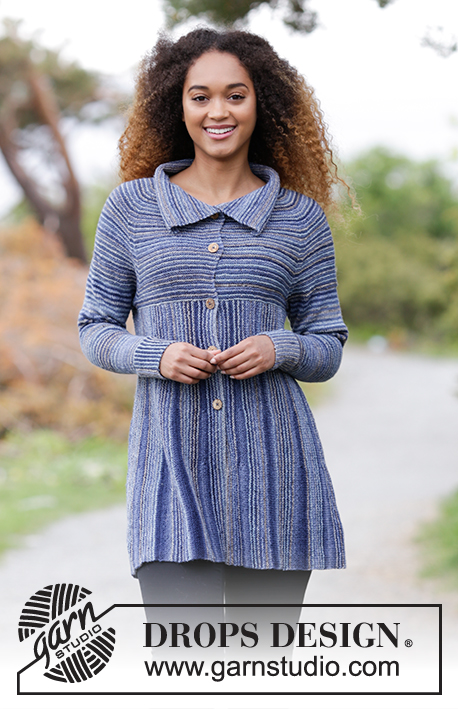 |
|||
Knitted jacket with garter stitch, short rows and raglan, worked sideways. Sizes S - XXXL. The piece is worked in DROPS Fabel.
DROPS 181-27 |
||||
|
INFORMATION FOR THE PATTERN: RIDGE/GARTER STITCH (worked back and forth): 1 ridge = Knit 2 rows. STRIPES: *Work 1 ridge with ocean view, 1 ridge with deep ocean*, repeat from *-* STRIPES SLEEVE: *Work 2 rows with ocean view, 2 rows with deep ocean *, repeat from *-*. SHORT ROWS: The complete repeat with short rows is worked with deep ocean. Start from the right side: Work 1 row over all stitches. Work the first 88 stitches, turn and work back. Work over the first 66 stitches, turn and work back. Work the first 44 stitches, turn and work back. Work the first 22 stitches, turn and work back. Work 0-2-2-4-4-4 rows over all stitches. Work the first 44 stitches, turn and work back. Work the first 66 stitches, turn and work back. Work the first 88 stitches, turn and work back. Work 3 rows over all stitches (= 18-20-20-22-22-22 rows in the bottom edge and 4-6-6-8-8-8 rows in the top edge). INCREASE TIP: Increase 2 stitches as follows: start 1 stitch before the marker thread, make 1 yarn over, knit 2 stitches (marker thread sits between these stitches), make 1 yarn over. On the next round knit the yarn overs twisted to prevent holes. RAGLAN: Decrease 8 stitches on each decrease row. Decrease as follows: Start 3 stitches before the marker thread, knit 2 stitches together, knit 2 stitches (= the marker thread sits between these stitches), slip 1 stitch, knit 1 stitch, pass the slipped stitch over the knitted stitch. If the knitting tension is not right in height and the work is too tight, the decreases to raglan will be too short and the armhole too small. You can adjust this by working 1 extra row without decreases, evenly between the decrease rows. BUTTONHOLES: Decrease for the buttonholes on the right band. 1 BUTTONHOLE = knit the 3rd and 4th stitch from the edge together and make 1 yarn over. On the next row, knit the yarn over = hole. Decrease for buttonhole when the piece measures: S: 9 and 18 cm M: 10 and 20 cm L: 7, 15 and 22 cm XL: 8, 16 and 24 cm XXL: 9, 17 and 26 cm XXXL:10, 19 and 28 cm --------------------------------------------------------- JACKET: The jacket is worked in two directions. First, work the bottom part sideways from mid front, then knit up stitches along the top side and work the top part of the jacket upwards. BOTTOM PART: Cast on 110 stitches in all sizes with circular needle size 3 mm and ocean view. Work STRIPES – see description above. Work 4 RIDGES – see description above, on the next row, decrease to buttonhole as follows – from the right side: Work 3 stitches, * knit 2 stitches together, 1 yarn over, work 24 stitches *, work from *-* a total of 2 times, knit 2 stitches together, 1 yarn over, work to end of row. On the next row, knit the yarn overs, there will be holes. Continue until you have worked a total of 9 ridges (= 18 rows), change to deep ocean and work SHORT ROWS – see description above. * Work 11-11-13-13-15-17 ridges with stripes (start and finish with ocean view). Change to deep ocean and work SHORT ROWS*, repeat from *-* until you have worked a total of 17 repeats with short rows. REMEMBER THE KNITTING TENSION! The piece should now measure 82-92-104-110-122-134 cm. If the piece measures less than this, you can work an extra repeat of garter stitch and short rows (make sure the piece ends with short rows). Finally, work 9 ridges over all stitches with stripes (start and finish with ocean view). Then cast off. TOP PART: The rest of the jacket is now worked upwards. Knit up from the right side 1 stitch in each ridge in the top edge of the jacket with circular needle size 3 mm and ocean view. Knit the next row from the wrong side and adjust the number of stitches to 228-245-277-294-326-358 stitches. Continue with garter stitch and stripes. THE PIECE IS NOW MEASURED FROM HERE! Work garter stitch for 2 cm, then work the next row as follows – from the right side: Work the first 56-61-68-72-79-86 stitches (= front piece), cast off the next 10-10-12-12-14-16 stitches, work the next 96-103-117-126-140-154 stitches (= back piece), cast off the next 10-10-12-12-14-16 stitches and work the last 56-61-68-72-79-86 stitches (= front piece). Lay the piece to one side and work the sleeves. SLEEVES: CUFF: Cast on 20 stitches with circular needle size 3 mm and ocean view. Work stripes and garter stitch back and forth on the needle until you have worked 50-52-54-56-60-62 ridges. Cast off. Sew the cast-on edge and the cast-off edge together. Knit up 1 stitch in each ridge from one side of the cuff = 50-52-54-56-60-62 stitches. THE PIECE IS NOW MEASURED FROM HERE! Work stocking stitch and stripes – see description above. Insert 1 marker thread at the beginning of the round = mid under the sleeve. When the piece measures 4 cm increase 1 stitch on each side of the marker thread – see INCREASE TIP above. Increase every 2 ½-1½-1½-1-1-1 cm a total of 13-17-21-22-23-25 times = 76-86-96-100-106-112 stitches. When the sleeve measures 38-36-35-34-32-31 cm cast off 10-10-12-12-14-16 stitches mid under the sleeve (= 5-5-6-6-7-8 stitches on each side of the marker thread) = 66-76-84-88-92-96 stitches. Lay the piece to one side and work 1 more sleeve. YOKE: Place the sleeves on the same circular needle as the body, where you have cast off for the armholes = 340-377-421-446-482-518 stitches. Insert 1 marker thread in each transition from body to sleeves = 4 marker threads. READ BUTTONHOLE! Continue with garter stitch and stripes, AT THE SAME TIME decrease to raglan on each side of each marker thread – READ RAGLAN. Decrease to raglan on every 4th row 19-20-21-23-24-26 times and every 2nd row 6-9-12-12-14-16 times. After all the decreases to raglan there are 140-145-157-166-178-182 stitches on the needle. Knit 1 row from the right side where the stitches at the top of the sleeves are knitted together 2 and 2 and you decrease 8-7-15-18-26-26 stitches evenly on row as well = 116-120-124-132-136-144 stitches. Work 2 ridges, on the last row of the ridges, increase 20 stitches evenly on row = 136-140-144-152-156-164 stitches. Work garter stitch and stripes for 8-8-8-9-9-9 cm, then cast off. ASSEMBLY: Sew the openings under the sleeves and sew on the buttons to the left front piece. |
||||
Diagram explanations |
||||
|
||||

|
||||
|
Have you made this or any other of our designs? Tag your pictures in social media with #dropsdesign so we can see them! Do you need help with this pattern?You'll find tutorial videos, a Comments/Questions area and more by visiting the pattern on garnstudio.com. © 1982-2024 DROPS Design A/S. We reserve all rights. This document, including all its sub-sections, has copyrights. Read more about what you can do with our patterns at the bottom of each pattern on our site. |
||||
With over 40 years in knitting and crochet design, DROPS Design offers one of the most extensive collections of free patterns on the internet - translated to 17 languages. As of today we count 304 catalogues and 11422 patterns - 11422 of which are translated into English (UK/cm).
We work hard to bring you the best knitting and crochet have to offer, inspiration and advice as well as great quality yarns at incredible prices! Would you like to use our patterns for other than personal use? You can read what you are allowed to do in the Copyright text at the bottom of all our patterns. Happy crafting!







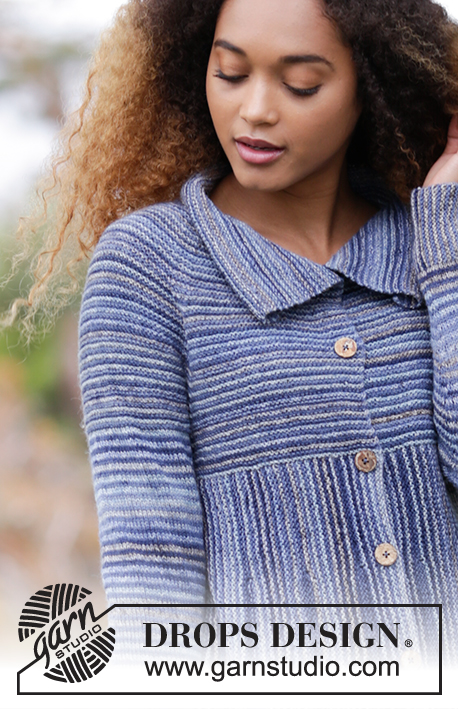
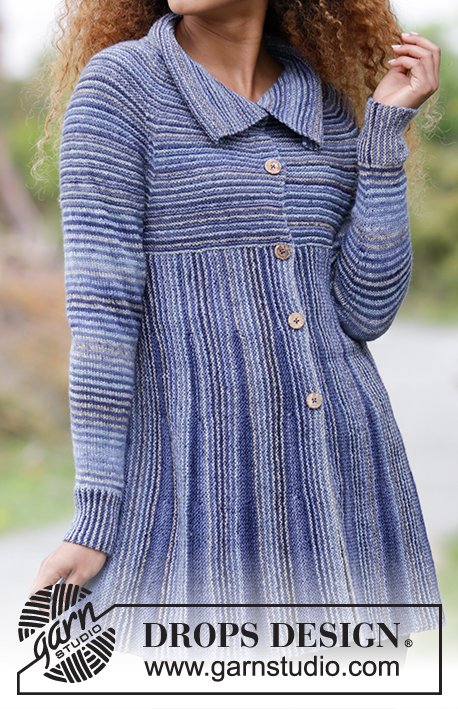


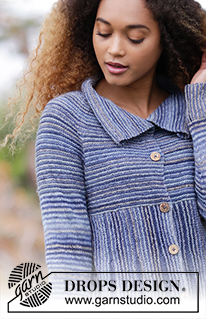





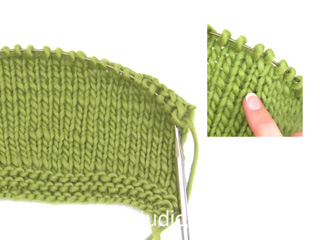



































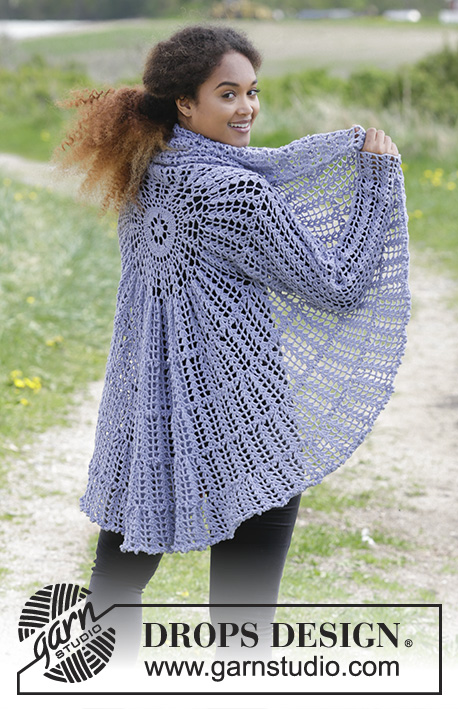




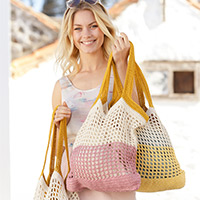
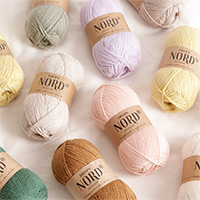
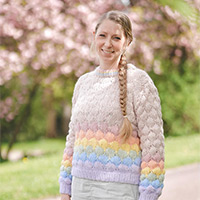
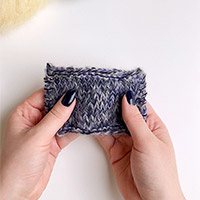
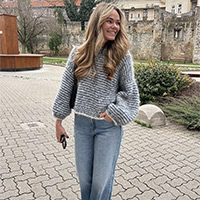

Comments / Questions (41)
Bei Abnahme der Rundpasse ergeben sich nur 4 Maschen Abnahme nach Ihrer Anleitung. Sie beschreiben jedoch 8 Maschen Abnahme. Es sind doch aber nur jeweils 2 Maschen vor und nach den Markierungsfäden zusammenzustricken bzw. Überzogen zusammen zu stricken.Das sind nach meinen Berechnungen 4 Maschen und nicht wie beschrieben 8 Maschen in jeder 4. Reihe. Bitte um Ihre Hilfe. Vielen Dank.
05.08.2019 - 00:24DROPS Design answered:
Liebe Frau Gerlach, es werden 8 Maschen für den Raglan abgenommen: stricken Sie bis 3 M vor dem Markierer übrig sind, dann 2 M re zusammen (= 1 Abnahme), 2 M re stricken (1 M vor + 1 M nach dem Markierer), und dann 1 Masche abheben, 1 Masche rechts, die abgehobene Masche über die gestrickte ziehen (= 1 Abnahme) = 2 Abnahmen bei jedem Markierungsfaden x 4 Markierungsfäden = 8 Abnahmen. Viel Spaß beim stricken!
07.08.2019 - 10:40Bonsoir :j'ai monté 110m avec aiguilles 3 mais je n'ai que 45cm au lieu de 48 :dois je tricoter avec des aiguilles 3/5 ::SVP
04.04.2019 - 20:23DROPS Design answered:
Bonjour Mme Josiane Llegou! La taille des aiguilles indiquée dans les explications n'est qu'une proposition. L'important est de bien avoir la bonne tension/le bon échantillon. Comme la tension est quelque chose de très personnel, il vous faudra ajuster la taille des aiguilles pour que VOTRE tension soit bien la même que dans le modèle - vous devrez peut-être utiliser une aiguille d'1 voir 2 tailles au-dessus ou au-dessous pour obtenir le bon échantillon. C'est pourquoi nous recommandons de tricoter des échantillons. Bon tricot!
05.04.2019 - 18:33Werden die armen nach der manchette hin und zurück gerstrickt oder in runden Wie meinen Sie glatt rechts Hin rechts Stricken und rück Reihe links Bei Streifen Ärmel steht Nichts beschrieben
23.09.2018 - 00:32DROPS Design answered:
Liebe Frau Müller, die Ärmel werden glatt rechts in der Runde gestrickt, dh alle Runde rechts stricken und gleichzeitig die Streifen folgen. Viel Spaß beim stricken!
24.09.2018 - 09:12Ik ben er niet helemaal uit wat betreft jullie maten. Bedoelen jullie met borstomtrek over de borsten gemeten, breedste gedeelte? Het blijft wat vaag, en om het breiwerk uit te halen is nou ook niet het leukste.Al mijn vesten zijn oversized, maar dit vest moet passen.
13.08.2018 - 12:08DROPS Design answered:
Dag Sonja, Ja, de borstomtrek (of bovenwijdte) is altijd gemeten over het breedste punt, dus over de buste en de schoudermaten. (De taille is gemeten over het smalste punt en de heup weer over het breedste punt). De afmetingen die op de tekening onder een patroon staan aangegeven zijn niet de omtrek, maar de breedte (dus de helft van de omtrek). In deze link vind je ook informatie over de maattekeningen
14.08.2018 - 10:17Ska ärmarna stickas i slätstickning??? Det ser ut som rätstickning på bilden. Mvh Maj-Britt
10.03.2018 - 11:03DROPS Design answered:
Hej Maj-Britt, manchetten strikkes i retstrik/riller og resten i glatstrik/slätstickning. God fornøjelse!
13.03.2018 - 16:16Na het breien van de manchetten, volgt de tekst: Neem 1 steek op in elke ribbel vanaf een kant van de manchet = 50-52-54-56-60-62 steken. HET WERK WORDT NU VANAF HIER GEMETEN! Brei tricotsteek en strepen Wordt hier bedoeld "ribbelsteken"????
06.03.2018 - 11:06DROPS Design answered:
Hallo Edith, Het staat inderdaad niet duidelijk aangegeven. Er wordt ribbelsteek mee bedoeld en omdat je in de rondte breit, betekent dat *1 naald recht, 1 naald averecht*. Herhaal van *-*.
09.03.2018 - 16:37Und die Streifen auch Kraus rechts oder glatt rechts oder wie entstehen die tollen Falten im unteren Teil
19.02.2018 - 13:33DROPS Design answered:
Liebe Frau Meyer, die Streifen beim unteren und oberen Teil werden kraus rechts gestrickt. Die Streifen bei den Ärmeln werden glatt rechts gestrickt. Viel Spaß beim stricken!
19.02.2018 - 15:41Wie wird die jacke gestrickt nur kraus rechts wie sind die verkürzten reihen gestrickt glatt oder kraus
18.02.2018 - 12:12DROPS Design answered:
Liebe Frau Meyer, die Jacke wird kraus rechts gestrickt, also das untere Teil mit verkürzten Reihen sowie das obere Teil, Ärmel werden nach den Manschette glatt rechts gestrickt und dann Passe wird krausrechts gestrickt. Viel Spaß beim stricken!
19.02.2018 - 09:58Hei! Hihan ohjeessa neuvotaan ottamaan silmukat kalvosimen reunasta ja neulomaan sileää neuletta kaarrokkeeseen asti. Kaarroke neulomaan aina oikein neuleella. Vaihtuuko siis sileä neule kesken hihan aina oikein neuleeksi?
07.11.2017 - 11:15DROPS Design answered:
Kyllä, hihassa neulotaan sekä ainaoikeaa että sileää neuletta.
08.11.2017 - 14:20Els Molenaar wrote:
Op welke hoogte maak ik de knoopsgaten in het bovenste deel?
02.10.2017 - 10:27DROPS Design answered:
Hallo Els, Dit staat voor elke maat aangegeven bovenaan in het patroon.
07.10.2017 - 16:57